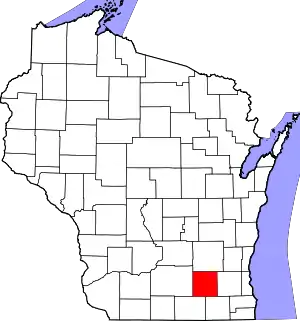Whitewater, Wisconsin
Whitewater is a city located in Walworth and Jefferson counties in the U.S. state of Wisconsin. Located near the southern portion of the Kettle Moraine State Forest, Whitewater is the home of the University of Wisconsin–Whitewater. As of the 2020 census, the city's population was 14,889.[5]
Whitewater, Wisconsin | |
|---|---|
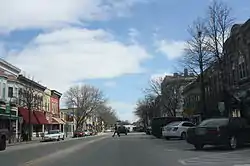 Main Street, downtown Whitewater | |
 Location of Whitewater in Walworth County and Jefferson County, Wisconsin. | |
| Coordinates: 42°50′6″N 88°44′10″W | |
| Country | United States |
| State | Wisconsin |
| Counties | Walworth, Jefferson |
| Government | |
| • Type | Common Council |
| Area | |
| • Total | 9.14 sq mi (23.67 km2) |
| • Land | 8.84 sq mi (22.89 km2) |
| • Water | 0.30 sq mi (0.77 km2) |
| Elevation | 824 ft (251 m) |
| Population | |
| • Total | 14,889 |
| • Density | 1,684.95/sq mi (650.58/km2) |
| Time zone | UTC-6 (Central (CST)) |
| • Summer (DST) | UTC-5 (CDT) |
| Zip Code | 53190 |
| Area code | 262 |
| FIPS code | 55-86925[4] |
| GNIS feature ID | 1576690[2] |
| Website | www |
History
Whitewater was founded at the confluence of Whitewater Creek and Spring Brook, and named for the white sand in their beds.[6] A gristmill was built on Whitewater creek, the resulting pond now called Cravath Lake. The town grew quickly when the first railroad line in Wisconsin passed through in 1853, but struggled when the two largest employers left town.[6]
Whitewater was originally founded entirely by settlers who arrived there from New England. These people were "Yankees", that is to say they were descended from the English Puritans who settled New England in the 1600s. They were part of a wave of New England farmers who headed west into what was then the wilds of the Northwest Territory during the early 1800s. Most of them arrived as a result of the completion of the Erie Canal. When they arrived in what is now Whitewater, then nothing but dense virgin forest and wild prairie, the New Englanders laid out farms, constructed roads, erected government buildings and established post routes. They brought with them many of their Yankee New England values, such as staunch support for abolitionism and a passion for education, establishing many schools as well. They were mostly members of the Congregationalist Church though some were Episcopalian. Due to the second Great Awakening some of them had converted to Methodism before moving to what is now Whitewater. Whitewater, like much of Wisconsin, would be culturally very continuous with early New England culture for most of its early history.[7][8]
Unlike much of Wisconsin, Walworth County was notable for not being heavily German-American, Whitewater had almost no German-Americans at a time when the state as a whole was receiving many.[9] Whitewater in particular and Walworth County in general were also heavily anti-slavery, and the abolitionist movement was popular amongst the New England descended portion of the population in the area.[9]
In the late 1800s immigrant families primarily from Belgium, Canada, Russia and Serbia settled in Whitewater, as well as smaller amounts of immigrants from France and England.[10]
Geography
According to the United States Census Bureau, the city has a total area of 9.06 square miles (23.47 km2), of which, 8.76 square miles (22.69 km2) is land and 0.30 square miles (0.78 km2) is water.[11] Most of the city lies in Walworth County.
Demographics
2020 census
As of the census of 2020, there were 14,889 people, 4,767 households, and 1,806 families living in the city. The population density was 1,684.95 inhabitants per square mile (650.6/km2). The racial makeup of the city was 78.8% White, 4.2% African American, 0.5% Native American, 2.5% Asian, 0.04% Pacific Islander, 7.2% from other races, and 6.4% from two or more races.
There were 4,767 households, of which 19.9% had one or more people under the age of 18 living with them, and 25.5% had one or more people 60 years or older living in them, with 9.9% having someone living alone who was 65 years or older. The average household size was 2.32 and the average family size was 3.01.
The median age in the city was 21.6 years. 10.6% of residents were under the age of 18; 57.3% were between the ages of 18 and 24; 71.5% were 15 to 44 years old. The gender makeup of the city was 50.9% male and 49.1% female.
| Census | Pop. | Note | %± |
|---|---|---|---|
| 1860 | 2,731 | — | |
| 1880 | 3,617 | — | |
| 1890 | 4,359 | 20.5% | |
| 1900 | 3,405 | −21.9% | |
| 1910 | 3,224 | −5.3% | |
| 1920 | 3,215 | −0.3% | |
| 1930 | 3,465 | 7.8% | |
| 1940 | 3,689 | 6.5% | |
| 1950 | 5,101 | 38.3% | |
| 1960 | 6,380 | 25.1% | |
| 1970 | 12,038 | 88.7% | |
| 1980 | 11,520 | −4.3% | |
| 1990 | 12,636 | 9.7% | |
| 2000 | 13,437 | 6.3% | |
| 2010 | 14,390 | 7.1% | |
| 2020 | 14,889 | 3.5% | |
| U.S. Decennial Census[12] | |||
2010 census
As of the census[3] of 2010, there were 14,390 people, 4,766 households, and 1,781 families living in the city. The population density was 1,642.7 inhabitants per square mile (634.3/km2). There were 5,113 housing units at an average density of 583.7 per square mile (225.4/km2). The racial makeup of the city was 88.0% White, 3.5% African American, 0.3% Native American, 1.9% Asian, 0.1% Pacific Islander, 4.5% from other races, and 1.8% from two or more races. Hispanic or Latino of any race were 9.5% of the population.
There were 4,766 households, of which 18.8% had children under the age of 18 living with them, 26.2% were married couples living together, 7.4% had a female householder with no husband present, 3.8% had a male householder with no wife present, and 62.6% were non-families. 34.6% of all households were made up of individuals, and 9.7% had someone living alone who was 65 years of age or older. The average household size was 2.28 and the average family size was 3.01.
The median age in the city was 21.9 years. 11.9% of residents were under the age of 18; 53.5% were between the ages of 18 and 24; 14.7% were from 25 to 44; 11.8% were from 45 to 64; and 8.4% were 65 years of age or older. The gender makeup of the city was 50.7% male and 49.3% female.
2000 census
As of the census of 2000,[4] there were 13,437 people, 4,132 households, and 1,685 families living in the city. The population density was 1,923.5 people per square mile (742.2/km2). There were 4,340 housing units at an average density of 621.3 per square mile (239.7/km2). The racial makeup of the city was 92.25% White, 2.34% African American, 0.27% Native American, 1.47% Asian, 0.01% Pacific Islander, 2.48% from other races, and 1.18% from two or more races. Hispanic or Latino of any race were 6.50% of the population.
There were 4,132 households, out of which 19.3% had children under the age of 18 living with them, 30.5% were married couples living together, 7.1% had a female householder with no husband present, and 59.2% were non-families. 32.7% of all households were made up of individuals, and 10.7% had someone living alone who was 65 years of age or older. The average household size was 2.38 and the average family size was 3.00.
In the city, the population was spread out, with 12.5% under the age of 18, 53.2% from 18 to 24, 15.7% from 25 to 44, 9.8% from 45 to 64, and 8.9% who were 65 years of age or older. The median age was 22 years. For every 100 females, there were 95.6 males. For every 100 females age 18 and over, there were 94.1 males.
The median income for a household in the city was $31,600, and the median income for a family was $48,185. Males had a median income of $33,078 versus $22,431 for females. The per capita income for the city was $13,965. About 10.6% of families and 27.4% of the population were below the poverty line, including 17.3% of those under age 18 and 4.2% of those age 65 or over. (Note: information in this paragraph is still from the 2000 census.)
Arts and culture
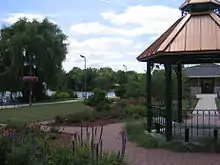
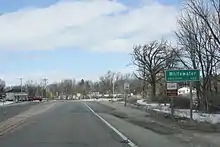
Annual events in Whitewater include "Freeze Fest" in January, the Bridal Fair, Farm Toy Show in February, Maxwell Street Day and the 4th of July Celebration in July. The Minneiska Water Ski Shows perform in the summer on Whitewater Lake.[13] Departing from the Highway 12 crossing of the Ice Age Trail, group biking tours depart several times a week from the area. September through April, Young Auditorium at the university hosts entertainment.[14]
Places of worship
- Anchor Bible Church[15]
- Community of St. Patrick Catholic Church
- Congregational United Church of Christ[16]
- First English Lutheran Church
- First United Methodist Church[17]
- Kettle Moraine Baptist Church[18]
- Living Word Fellowship[19]
- Whitewater Bible Church
- Whitewater Family Church[20]
- Whitewater Islamic center[21]
- Crosspointe Community Church
- Hope Ministries
Parks and recreation
There are five community parks in Whitewater: Cravath Lakefront Park, Moraine View Park, Starin Park, Trippe Lake Park, and Whitewater Creek Nature Area. Effigy Mounds Preserve is an archeological park.[22] An aquatic and fitness center is located in Whitewater.[23]
Government
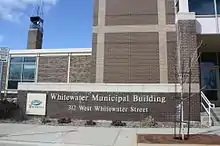
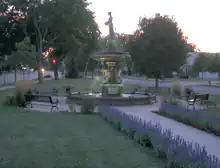
Whitewater has a council-manager form of government. The city manager is Cameron Clapper and the municipal judge is Patrick Taylor. The Whitewater Common Council is made up of one member from each of the five districts and two members-at-large. The Common Council meets on the first and third Tuesdays of the month at City Hall, with its meetings being broadcast live on Whitewater Public Television.[24]
Education
Whitewater is served by the Whitewater Unified School District (WWUSD), which has five schools and one university in the city:
- Lakeview Elementary School
- Lincoln Elementary School
- Washington Elementary School
- Whitewater Middle School (WMS)
- Whitewater High School (WHS)
- University of Wisconsin–Whitewater
Kettle Moraine Baptist Academy, which serves students in grades kindergarten through 12, is also located in the city.[25]
Notable people
- Stephen Ambrose, author, historian
- George Awsumb, architect
- James C. Bartholf, Wisconsin politician and newspaper editor
- Zadoc P. Beach, Wisconsin politician
- Marvin H. Bovee, Wisconsin politician
- Edwin Coe, newspaper editor and politician[26]
- Charles Coleman, Wisconsin politician
- Edward S. Curtis, photographer, director, actor, cinematographer
- Frank A. Dudley, New York state legislator and lawyer
- Jeffrey Foucault, recording artist
- Eva Kinney Griffith, journalist, temperance activist
- Ben Heller, Major League baseball player
- George W. Hull, Wisconsin politician
- Jeff Jagodzinski, NFL assistant coach, former head coach of the Boston College Eagles
- Dale Markham, NFL player
- Benjamin McCready, painter
- Stephen Nass, Wisconsin politician
- Leon Pescheret, fine artist, designer, printmaker
- Elaine Roe, U.S. Army officer, one of the first four women to be awarded the Silver Star
- Edward J. Roethe, Wisconsin legislator
- Henry Edgar Roethe, Wisconsin legislator
- Byron Storm, Wisconsin legislator
- Eric Studesville, NFL assistant coach
- Eleazer Wakeley, Justice of the Nebraska Territory Supreme Court
- Jerome Anthony Watrous (1840–1922), was an American author, newspaper writer, Republican politician, and a Lt. Colonel as a US soldier
- Thompson Weeks, Wisconsin politician
- Samuel A. White, Wisconsin politician
References
- "2019 U.S. Gazetteer Files". United States Census Bureau. Retrieved August 7, 2020.
- U.S. Geological Survey Geographic Names Information System: Whitewater, Wisconsin
- "U.S. Census website". United States Census Bureau. Retrieved November 18, 2012.
- "U.S. Census website". United States Census Bureau. Retrieved January 31, 2008.
- "QuickFacts - Whitewater city, Wisconsin; United States". United States Census Bureau. Retrieved June 12, 2022.
- History of Whitewater Archived 2008-01-25 at the Wayback Machine
- History of Walworth County, Wisconsin by Albert Clayton Beckwith, 1912 page 779
- The History of Wisconsin by William Fletcher Thompson State Historical Society of Wisconsin, Dec 1, 1998 ISBN 9780870203039
- Wisconsin Votes: An Electoral History, Volume 3 by Robert Booth Fowler pg. 11-12
- History of Whitewater, Wisconsin by Mary Janette Bohi
- "US Gazetteer files 2010". United States Census Bureau. Retrieved November 18, 2012.
- "Census of Population and Housing". Census.gov. Retrieved June 4, 2015.
- Whitewaterskiteam.org
- "UWW.edu". Archived from the original on February 19, 2007. Retrieved January 26, 2007.
- Anchor Bible Church
- "Congregational United Church of Christ". Archived from the original on July 18, 2013. Retrieved July 31, 2013.
- "FUMC Home Page". Fumcwhitewater.org. Retrieved October 5, 2013.
- Kettle Moraine Baptist Church
- Living Word Fellowship
- Whitewater Family Church
- whitewater Islamic center
- "Parks, Preserves and Paths". City of Whitewater. Retrieved December 23, 2020.
- "About the Aquatic Center". City of Whitewater. Retrieved December 23, 2020.
- "Common Council | Whitewater, WI". www.whitewater-wi.gov. Retrieved June 11, 2022.
- Kettle Moraine Baptist Academy
- 'Wisconsin Blue Book 1887,' Biographical Sketch of Edwin Coe, pg. 512
Further reading
- Kraege, Fred G. Whitewater. Charleston, SC: Arcadia Press, 2006.
